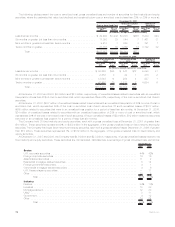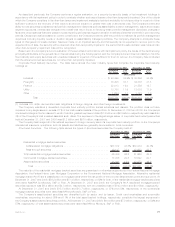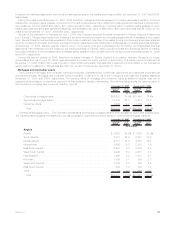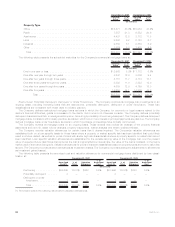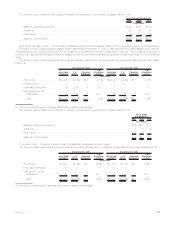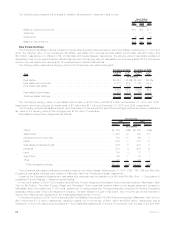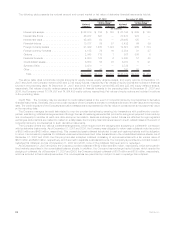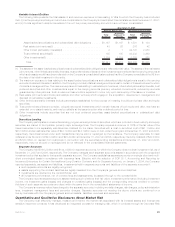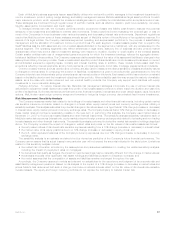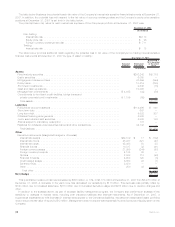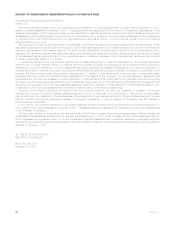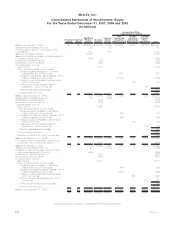MetLife 2007 Annual Report Download - page 90
Download and view the complete annual report
Please find page 90 of the 2007 MetLife annual report below. You can navigate through the pages in the report by either clicking on the pages listed below, or by using the keyword search tool below to find specific information within the annual report.Management Department, ALM Committees and additional specialists at the business segment level. The Company has established and
implemented comprehensive policies and procedures at both the corporate and business segment level to minimize the effects of potential
market volatility.
The Company regularly analyzes its exposure to interest rate, equity market and foreign currency exchange risks. As a result of that
analysis, the Company has determined that the fair value of its interest rate sensitive invested assets is materially exposed to changes in
interest rates. The equity and foreign currency portfolios do not expose the Company to material market risks (as described below).
MetLife generally uses option adjusted duration to manage interest rate risk and the methods and assumptions used are generally
consistent with those used by the Company in 2006. The Company analyzes interest rate risk using various models, including multi-
scenario cash flow projection models that forecast cash flows of the liabilities and their supporting investments, including derivative
instruments. The Company uses a variety of strategies to manage interest rate, equity market, and foreign currency exchange risk,
including the use of derivative instruments.
Market Risk Exposures
The Company has exposure to market risk through its insurance operations and investment activities. For purposes of this disclosure,
“market risk” is defined as the risk of loss resulting from changes in interest rates, equity market prices and foreign currency exchange
rates.
Interest Rates. The Company’s exposure to interest rate changes results from its significant holdings of fixed maturity securities, as
well as its interest rate sensitive liabilities. The fixed maturity securities include U.S. and foreign government bonds, securities issued by
government agencies, corporate bonds and mortgage-backed securities, all of which are mainly exposed to changes in medium- and long-
term treasury rates. The interest rate sensitive liabilities for purposes of this disclosure include GICs and annuities, which have the same
type of interest rate exposure (medium- and long-term treasury rates) as fixed maturity securities. The Company employs product design,
pricing and asset/liability management strategies to reduce the adverse effects of interest rate movements. Product design and pricing
strategies include the use of surrender charges or restrictions on withdrawals in some products. Asset/liability management strategies
include the use of derivatives, the purchase of securities structured to protect against prepayments, prepayment restrictions and related
fees on mortgage loans and consistent monitoring of the pricing of the Company’s products in order to better match the duration of the
assets and the liabilities they support. See also “Risk Factors — Changes in Market Interest Rates May Significantly Affect Our Profitability’’
in MetLife, Inc.’s Annual Report on Form 10-K for the year ended December 31, 2007.
Equity Market Prices. The Company’s investments in equity securities and equity-based fixed maturity securities expose it to changes
in equity prices, as do certain liabilities that involve long-term guarantees on equity performance. It manages this risk on an integrated basis
with other risks through its asset/liability management strategies. The Company also manages equity market price risk through industry and
issuer diversification, asset allocation techniques and the use of derivatives.
Foreign Currency Exchange Rates. The Company’s exposure to fluctuations in foreign currency exchange rates against the U.S. dollar
results from its holdings in non-U.S. dollar denominated fixed maturity securities, equity securities and liabilities, as well as through its
investments in foreign subsidiaries. The principal currencies that create foreign currency exchange rate risk in the Company’s investment
portfolios are the Euro, the Canadian dollar and the British pound. The Company mitigates its fixed maturity securities’ foreign currency
exchange rate risk through the utilization of foreign currency swaps and forward contracts. Through its investments in foreign subsidiaries,
the Company is primarily exposed to the Canadian dollar, the Mexican peso, the Australian dollar, the Argentinean peso, the South Korean
won,theChileanpeso,theTaiwanesedollarandtheJapaneseyen.TheCompanyhasmatchedsubstantiallyallofitsforeigncurrency
liabilities in its foreign subsidiaries with their respective foreign currency assets, thereby reducing its risk to currency exchange rate
fluctuation. Selectively, the Company uses U.S. dollar assets to support certain long duration foreign currency liabilities. Additionally, in
some countries, local surplus is held entirely or in part in U.S. dollar assets which further minimizes exposure to exchange rate fluctuation
risk.
Risk Management
Corporate Risk Management. MetLife has established several financial and non-financial senior management committees as part of its
risk management process. These committees manage capital and risk positions, approve asset/liability management strategies and
establish appropriate corporate business standards.
MetLife also has a separate Corporate Risk Management Department, which is responsible for risk throughout MetLife and reports to
MetLife’s Chief Financial Officer. The Corporate Risk Management Department’s primary responsibilities consist of:
• implementing a Board of Directors-approved corporate risk framework, which outlines the Company’s approach for managing risk on
an enterprise-wide basis;
• developing policies and procedures for managing, measuring and monitoring those risks identified in the corporate risk framework;
• establishing appropriate corporate risk tolerance levels;
• deploying capital on an economic capital basis; and
• reporting on a periodic basis to the Governance Committee of the Holding Company’s Board of Directors and various financial and
non-financial senior management committees.
Asset/Liability Management. The Company actively manages its assets using an approach that balances quality, diversification, asset/
liability matching, liquidity and investment return. The goals of the investment process are to optimize, net of income tax, risk-adjusted
investment income and risk-adjusted total return while ensuring that the assets and liabilities are managed on a cash flow and duration
basis. The asset/liability management process is the shared responsibility of the Portfolio Management Unit, the Financial Management and
Oversight Asset/Liability Management Unit, and the operating business segments under the supervision of the various product line specific
ALM Committees. The ALM Committees’ duties include reviewing and approving target portfolios on a periodic basis, establishing
investment guidelines and limits and providing oversight of the asset/liability management process. The portfolio managers and asset
sector specialists, who have responsibility on a day-to-day basis for risk management of their respective investing activities, implement the
goals and objectives established by the ALM Committees.
86 MetLife, Inc.


